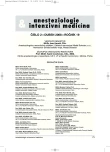Intramuscular dexmedetomidine in burns victims – preliminary results
Authors:
Málek Jiří; Hess Ladislav 2; Jandová Jaroslava 1; Šimánková Eva 1
Authors‘ workplace:
Klinika anesteziologie a resuscitace 3. LF Univerzity Karlovy v Praze a FNKV, Praha
1; IKEM, Praha
2
Published in:
Anest. intenziv. Med., 19, 2008, č. 2, s. 82-86
Category:
Anaesthesiology - Original Paper
Overview
Objective:
The aim was to evaluate the combination of dexmedetomidine and ketamine and dexmedetomidine, ketamine and midazolam.
Design:
Prospective randomised clinical study.
Setting:
Department of Anaesthesiology and Intensive Care, University Hospital.
Materials and methods Part 1:
Following ethics committee approval and written consent, patients treated for burns were divided into 4 groups according to the intramuscular dose of dexmedetomidine (D) 2 μg .kg⁻¹ or 2.5 μg .kg⁻¹ and ketamine (K) 2.0 mg.kg⁻¹ or 3.0 mg.kg⁻¹.
Results Part 1:
Total 43 anaesthetics were given to 18 patients. Combinations D2K2 and D2.5K3 were stopped for insufficient effect or excessive sedation respectively. No respiratory depression, airway obstruction, bradycardia or hypotension appeared and any combination suppressed the psychomimetic reactions to ketamine. The only difference found between D2K3 vs D2.5K2 was preserved cooperation in the former combination (p < 0.05).
Materials and methods Part 2:
To suppress the CNS effects of ketamine, either midazolam (M) 1 mg IM or placebo (P) was added to the combination of dexmedetomidine 2 μg . kg⁻¹ + ketamine 2 mg . kg⁻¹ (DKM or DKP combinations). The protocol was identical to Part 1.
Results Part 2:
The study was prematurely aborted after signs of excessive sedation in 7 patients and airway obstruction in some patients. Unconsciousness appeared in 5/7 vs. 0/7 in the DKM vs. DKP group (p < 0.05), the quality of anaesthesia improved in 4 patients in the DKM group.
Conclusions:
The combination of intramuscular dexmedetomidine 2.5 μg . kg⁻¹ with ketamine 2.0 mg . kg⁻¹ is more likely to preserve cooperation during anaesthesia than dexmedetomidine 2 μg . kg⁻¹with ketamine 3.0 mg . kg⁻¹ IM. Adding 1–2 mg of midazolam may result in vital function disturbances.
Keywords:
general anaesthesia – analgesic sedation – management of the burn patient – intramuscular administration – dexmedetomidine – ketamine – midazolam
Sources
1. Pandharipande, P., Ely, E. W., Maze, M. Alpha-2 agonists: can they modify the outcomes in the Postanesthesia Care Unit? Curr. Drug Targets, 2005, 6, p. 749–754.
2. Bell, R. F., Dahl, J. B., Moore, R. A., Kalso, E. Peri-operative ketamine for acute post-operative pain: a quantitative and qualitative systematic review (Cochrane review). Acta Anaesthesiol. Scand., 2005, 49, p. 1405–1428.
3. Schmid, R. L., Sandler, A. N., Katz, J. Use and efficacy of low-dose ketamine in the management of acute postoperative pain: a review of current techniques and outcomes. Pain, 1999, 82, p. 111–125.
4. Aantaa, R., Jalonen, J. Perioperative use of alpha2-adrenoceptor agonists and the cardiac patient. Eur. J. Anaesthesiol., 2006, 23, p. 361–372.
5. Tosun, Z., Akin, A., Guler, G. et al. Dexmedetomidine-ketamine and propofol-ketamine combinations for anesthesia in spontaneously breathing pediatric patients undergoing cardiac catheterization. J. Cardiothorac. Vasc. Anesth., 2006, 20, p. 515–519.
6. Luscri, N., Tobias, J. D. Monitored anesthesia care with a combination of ketamine and dexmedetomidine during magnetic resonance imaging in three children with trisomy 21 and obstructive sleep apnea. Paediatr. Anaesth., 2006, 16, p. 782–786.
7. Scher, C. S., Gitlin, M. C. Dexmedetomidine and low-dose ketamine provide adequate sedation for awake fibreoptic intubation. Can. J. Anaesth., 2003, 50, p. 607–610.
8. Levanen, J., Makela, M. L., Scheinin, H. Dexmedetomidine premedication attenuates ketamine-induced cardiostimulatory effects and postanesthetic delirium. Anesthesiology, 1995, 82, p. 1117–1125.
9. Málek, J., Jandová, J., Kurzová, A., Šimánková, E. Clonidin u popálených pacientů. Anest. neodkl. péče, 1999, 10, p. 186–189.
10. Málek, J., Jandová, J., Hess, L. et al. Clonidine in anaesthesia of burned. Acta Anaesthesiol. Scand., 1998, 42, p. A252.
11. Karaaslan, D., Peker, T. T., Alaca, A. et al. Comparison of buccal and intramuscular dexmedetomidine premedication for arthroscopic knee surgery. J. Clin. Anesth., 2006, 18, p. 589–593.
12. Erkola, O., Korttila, K., Aho, M. et al. Comparison of intramuscular dexmedetomidine and midazolam premedication for elective abdominal hysterectomy. Anesth. Analg., 1994, 79, p. 646–653.
13. Virkkila, M., Ali-Melkkila, T., Kanto, J. et al. Dexmedetomidine as intramuscular premedication for day-case cataract surgery. A comparative study of dexmedetomidine, midazolam and placebo. Anaesthesia, 1994, 49, s. 853–858.
14. Jaakola, M. L., Kanto, J., Scheinin, H., Kallio, A. Intramuscular dexmedetomidine premedication – an alternative to midazolam-fentanyl-combination in elective hysterectomy? Acta Anaesthesiol. Scand., 1994, 38, p. 238–243.
15. Scheinin, H., Jaakola, M. L., Sjovall, S. et al. Intramuscular dexmedetomidine as premedication for general anesthesia. A comparative multicenter study. Anesthesiology, 1993, 78, p. 1065–1075.
16. Virkkila, M., Ali-Melkkila, T., Kanto, J. et al. Dexmedetomidine as intramuscular premedication in outpatient cataract surgery. A placebo-controlled dose-ranging study. Anaesthesia, 1993, 48, p. 482–487.
17. Aantaa, R., Jaakola, M. L., Kallio, A. et al. A comparison of dexmedetomidine, and alpha-2 adrenoceptor agonist, and midazolam as i.m. premedication for minor gynaecological surgery. Br. J. Anaesth., 1991, 67, p. 402–409.
18. Aantaa, R., Kanto, J., Scheinin, M. Intramuscular dexmedetomidine, a novel alpha- 2 adrenoceptor agonist, as premedication for minor gynaecological surgery. Acta Anaesthesiol. Scand., 1991, 35, p. 283–288.
19. Reves, J., Glass, P., Lubarsky, D. A. Nonbarbiturate intravenous anesthetics. In: Miller, R. D., ed. Anesthesia. 5. vyd., Churchill Livingstone : Philadelphia, 2000, p. 240–245.
20. Salonen, M., Reid, K., Maze, M. Synergistic interaction between alpha 2-adrenergic agonists and benzodiazepines in rats. Anesthesiology, 1992, 76, p. 1004–1011.
21. Murai, T., Kyoda, N., Misaki, T. et al. Effects of clonidine on intravenous sedation with midazolam. Anesth. Prog., 1995, 42, p. 135–138.
Labels
Anaesthesiology, Resuscitation and Inten Intensive Care MedicineArticle was published in
Anaesthesiology and Intensive Care Medicine

2008 Issue 2
Most read in this issue
- Epidemiology of invasive candidiasis and candidemia – a persistent problem
- Tri-level pulmonary ventilation (3LV®) – initial clinical experience
- LMA-ProSeal™ laryngeal mask is a safe option for securing the airways for laparoscopic cholecystectomy
- Dexmedetomidine-ketamine intravenous sedation during local anaesthesia
